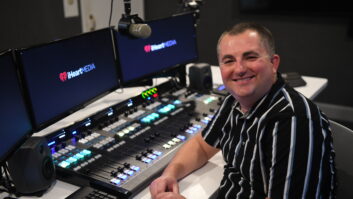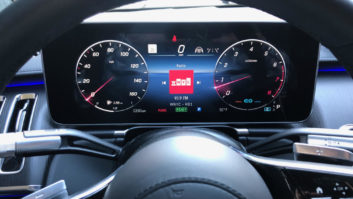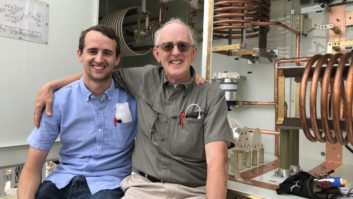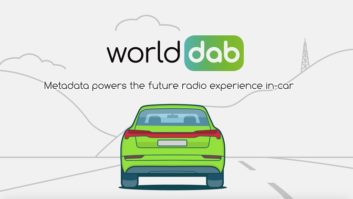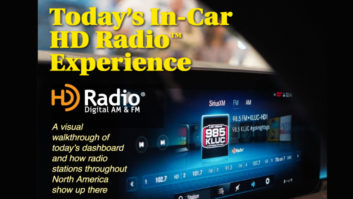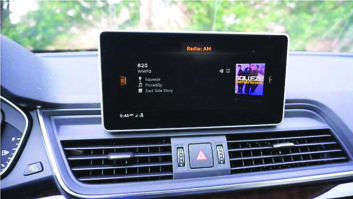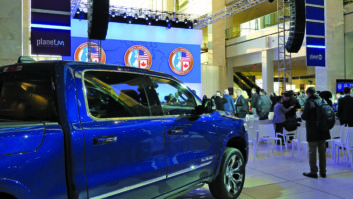Digital radio developer iBiquity Digital says it is focused on giving broadcasters more features they can offer consumers, with the goal of keeping terrestrial radio relevant in the dashboard.
That strategy is reflected in its plans for the spring NAB Show and major themes HD Radio proponents have been highlighting.
Terrestrial radio long has held a dominant position in the dash; but HD Radio proponents, among others, believe that era is ending as car companies and OEM receiver makers increasingly embrace other media in their entertainment systems.

IBiquity Digital demonstrated an HD Radio receiver with live Artist Experience in a 2012 Ford Focus at CES. Photo by Leslie Stimson For iBiquity, and for some in radio like Clear Channel’s Total Traffic Network and the Broadcast Traffic Consortium, the way to keep radio significant in the crowded dashboard is for stations transmitting analog/digital signals to provide associated HD Radio data features to consumers. That means multicasting; providing real-time traffic data; and enabling iTunes Tagging as well as HD’s newest feature, images synched to the audio content, called Artist Experience.
Artist Experience brings radio more up to date with what satellite radio receivers and cellphones provide, according to this mindset.
“This is a data-driven world, and consumers expect real-time information,” said Barbara Janiak, product manager for the BTC — information such as traffic and weather data and fuel prices on their radio displays.
Right now, consortium stations, both commercial and noncommercial, transmit traffic data as FM analog signals via RDS and as digital signals via HD Radio to Navteq for use by its navigation device partners.
Clear Channel stations do the same for its traffic partners Inrix and SpeedInfo. In January it announced new features to enhance the real-time traffic data service for consumers using the service via broadcast, the Web, wirelessly and through navigation devices.
‘The new dashboard’
“There will be a ton of people who come to NAB who’ve never seen what HD looks like on a dash these days,” said Stephen Baldacci, iBiquity senior vice president of marketing.
“We want attendees to experience the new dashboard, and all the work we’ve been doing on the user interface and these new features.” He added that iTunes Tagging is a relatively new feature on OEM HD Radio receivers, and that the tagging capability will be displayed.
The technology developer plans to feature Artist Experience in two booths. Both will have several radios displaying AE, using signals of at least one and perhaps two local broadcast owners, said Baldacci.
Now that some HD Radio devices on the market can display images along with the HD Radio audio, iBiquity wants to promote how attendees can monetize that feature. The data for images that a station transmits can include advertising displays or station branding images, along with programming material.
Though adoption of HD Radio continues, uptake by stations slowed notably in the past couple of years, particularly since the recession kicked in. More recently the numbers have been rising at a slower pace, as we’ve reported.
IBiquity expects a slow, steady climb for overall conversions, though it would like to see a faster pace of stations offering associated HD data features. A year ago February, 1,966 stations were licensed to transmit HD Radio. As of early February 2011, that number was approximately 2,030; a month later iBiquity put it at 2,121.
The HD rollout continues to be dominated by FMs. The FCC counts 1,627 FMs transmitting in HD Radio as of mid-March, including 1,030 commercial and 597 non-commercial stations, compared to 295 commercial AMs.
IBiquity is confident that enough stations transmit HD Radio to help reach advertisers in a meaningful way. Although the company would like more outlets to convert, “The stations we have today are dominant listening stations with plenty of reach to sell advertising.” It hopes to convey how new features like AE can add to the value of a station’s advertising, Baldacci said.
Multicast figures continue to rise, increasing by about 13 percent from this time last year.
One manufacturing source said there were a total of 1,133 multicast channels as of February 2010, with 970 HD2 and 163 HD3 channels. The multicasting figure, according to the same source, stood as of this February at 1,287, including 1,062 HD2 channels, 215 HD3 and 10 HD4.
Radio World reported about a year ago that iBiquity and other proponents also expected a slow rise in the number of FMs raising digital power, as budgets and equipment replacement cycles allowed. Some FMs now are raising digital sideband levels, to help their digital coverage area match their analog and to support advanced data services.
Whereas special temporary authority had been required earlier, now stations that want to raise power by 6 dB, to –14 dBc, can simply notify the FCC, while those wanting a 10 dB increase must still seek an STA.
The commission said 225 FMs had raised their digital power as of early March 2011, compared to 24 FMs with STAs for higher power a year ago. Of those at higher power now, 207 are operating at between –20 dBc and –14 dBc, most at the latter power level. Twelve were operating at greater than –14 dBc, and six super-powered FMs were operating with increased digital power, according to the commission.
Meanwhile, proponents believe more FM stations will be able to increase digital power levels if the FCC allows them to raise just one digital sideband. NAB FASTROAD released initial results of asymmetric sideband testing conducted by iBiquity; the developer is conducting further tests. With that data, combined with additional testing from NPR Labs, proponents hope to make the case to the commission to allow stations to raise only one digital sideband to implement a power increase.
As HD Radio receivers can now offer advanced HD data features, so too can new HD transmission equipment. Broadcast Electronics, Continental Electronics, Harris Broadcast and Nautel at NAB will exhibit HD Radio transmission equipment capable of supporting advanced data features and the higher FM power levels now allowed by the FCC.
“Broadcasters tell us they want to increase their FM digital power levels, definitely. But they want to find a way to do it without necessarily replacing their existing transmission system,” said Tim Bealor, vice president of sales for Broadcast Electronics.
Harris Broadcast Vice President Transmission Research & Technology Geoff Mendenhall said the manufacturer is seeing “significant interest” from stations wanting to increase their FM digital sideband power levels to increase their coverage area.
‘Long lens’
Critics argue that the digital conversion peaked before the recession really kicked in during 2008 and that the bulk of the stations interested in converting have done so — leaving those that invested in HD Radio in the minority, having purchased a costly technology that serves no broad receiver base.
They also feel that for all the data services iBiquity is trying to get stations to use, few do — especially tagging, which has generated little consumer awareness. Stations that are multicasting tend to pay scant attention to their extra channels, even to whether the channels are on the air, opponents argue. They say the AM rollout has essentially been a failure and that HD Radio continues to add noise to both bands.
IBOC critics also dispute the premise that radio needs to be digital to preserve space in the dash.
Bealor of BE said it’s understandable that some converted stations have been frustrated with the ensuing pace of the rollout.
However, he continued, “In the long lens of radio history, I suspect we’ll look back on HD Radio as being the one thing we all did as a community that really made a difference to the future viability of radio. We are talking about huge changes in radios and transmission equipment. And even more to the point, what we’re really doing is changing how the listener thinks about radio, and interacts with it. That kind of change doesn’t happen overnight.”





